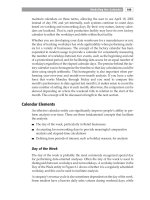Mastering Data Warehouse DesignRelational and Dimensional Techniques phần 1 pptx
Bạn đang xem bản rút gọn của tài liệu. Xem và tải ngay bản đầy đủ của tài liệu tại đây (1.21 MB, 46 trang )
Claudia Imhoff
Nicholas Galemmo
Jonathan G. Geiger
Mastering Data
Warehouse Design
Relational and Dimensional
Techniques
Vice President and Executive Publisher: Robert Ipsen
Publisher: Joe Wikert
Executive Editor: Robert M. Elliott
Developmental Editor: Emilie Herman
Editorial Manager: Kathryn Malm
Managing Editor: Pamela M. Hanley
Text Design & Composition: Wiley Composition Services
This book is printed on acid-free paper. ∞
Copyright © 2003 by Claudia Imhoff, Nicholas Galemmo, and Jonathan G. Geiger. All rights
reserved.
Published by Wiley Publishing, Inc., Indianapolis, Indiana
Published simultaneously in Canada
No part of this publication may be reproduced, stored in a retrieval system, or transmitted
in any form or by any means, electronic, mechanical, photocopying, recording, scanning, or
otherwise, except as permitted under Section 107 or 108 of the 1976 United States Copyright
Act, without either the prior written permission of the Publisher, or authorization through
payment of the appropriate per-copy fee to the Copyright Clearance Center, Inc., 222 Rose-
wood Drive, Danvers, MA 01923, (978) 750-8400, fax (978) 646-8700. Requests to the Pub-
lisher for permission should be addressed to the Legal Department, Wiley Publishing, Inc.,
10475 Crosspoint Blvd., Indianapolis, IN 46256, (317) 572-3447, fax (317) 572-4447, E-mail:
Limit of Liability/Disclaimer of Warranty: While the publisher and author have used their
best efforts in preparing this book, they make no representations or warranties with respect
to the accuracy or completeness of the contents of this book and specifically disclaim any
implied warranties of merchantability or fitness for a particular purpose. No warranty may
be created or extended by sales representatives or written sales materials. The advice and
strategies contained herein may not be suitable for your situation. You should consult with
a professional where appropriate. Neither the publisher nor author shall be liable for any
loss of profit or any other commercial damages, including but not limited to special, inci-
dental, consequential, or other damages.
For general information on our other products and services please contact our Customer
Care Department within the United States at (800) 762-2974, outside the United States at
(317) 572-3993 or fax (317) 572-4002.
Trademarks: Wiley, the Wiley Publishing logo and related trade dress are trademarks or
registered trademarks of Wiley Publishing, Inc., in the United States and other countries,
and may not be used without written permission. All other trademarks are the property of
their respective owners. Wiley Publishing, Inc., is not associated with any product or ven-
dor mentioned in this book.
Wiley also publishes its books in a variety of electronic formats. Some content that appears
in print may not be available in electronic books.
ISBN: 0-471-32421-3
Printed in the United States of America
10 9 8 7 6 5 4 3 2 1
DEDICATION
iii
Claudia: For all their patience and understanding throughout the years, this
book is dedicated to David and Jessica Imhoff.
Nick: To my wife Sarah, and children Amanda and Nick Galemmo, for their
understanding over the many weekends I spent working on this book. Also to
my college professor, Julius Archibald at the State University of New York at
Plattsburgh for instilling in me the science and art of computing.
Jonathan: To my wife, Alma Joy, for her patience and understanding of the time
spent writing this book, and to my children, Avi and Shana, who are embarking
on their respective careers and of whom I am extremely proud.
CONTENTS
v
Acknowledgments xv
About the Authors xvii
Part One Concepts 1
Chapter 1 Introduction 3
Overview of Business Intelligence 3
BI Architecture 6
What Is a Data Warehouse? 9
Role and Purpose of the Data Warehouse 10
The Corporate Information Factory 11
Operational Systems 12
Data Acquisition 12
Data Warehouse 13
Operational Data Store 13
Data Delivery 14
Data Marts 14
Meta Data Management 15
Information Feedback 15
Information Workshop 15
Operations and Administration 16
The Multipurpose Nature of the Data Warehouse 16
Types of Data Marts Supported 17
Types of BI Technologies Supported 18
Characteristics of a Maintainable Data
Warehouse Environment 20
The Data Warehouse Data Model 22
Nonredundant 22
Stable 23
Consistent 23
Flexible in Terms of the Ultimate Data Usage 24
The Codd and Date Premise 24
Impact on Data Mart Creation 25
Summary 26
Chapter 2 Fundamental Relational Concepts 29
Why Do You Need a Data Model? 29
Relational Data-Modeling Objects 30
Subject 31
Entity 31
Element or Attribute 32
Relationships 34
Types of Data Models 35
Subject Area Model 37
Subject Area Model Benefits 38
Business Data Model 39
Business Data Model Benefits 39
System Model 43
Technology Model 43
Relational Data-Modeling Guidelines 45
Guidelines and Best Practices 45
Normalization 48
Normalization of the Relational Data Model 48
First Normal Form 49
Second Normal Form 50
Third Normal Form 51
Other Normalization Levels 52
Summary 52
Part Two Model Development 55
Chapter 3 Understanding the Business Model 57
Business Scenario 58
Subject Area Model 62
Considerations for Specific Industries 65
Retail Industry Considerations 65
Manufacturing Industry Considerations 66
Utility Industry Considerations 66
Property and Casualty Insurance Industry Considerations 66
Petroleum Industry Considerations 67
Health Industry Considerations 67
Subject Area Model Development Process 67
Closed Room Development 68
Development through Interviews 70
Development through Facilitated Sessions 72
Subject Area Model Benefits 78
Subject Area Model for Zenith Automobile Company 79
Contents
vi
Business Data Model 82
Business Data Development Process 82
Identify Relevant Subject Areas 83
Identify Major Entities and Establish Identifiers 85
Define Relationships 90
Add Attributes 92
Confirm Model Structure 93
Confirm Model Content 94
Summary 95
Chapter 4 Developing the Model 97
Methodology 98
Step 1: Select the Data of Interest 99
Inputs 99
Selection Process 107
Step 2: Add Time to the Key 111
Capturing Historical Data 115
Capturing Historical Relationships 117
Dimensional Model Considerations 118
Step 3: Add Derived Data 119
Step 4: Determine Granularity Level 121
Step 5: Summarize Data 124
Summaries for Period of Time Data 125
Summaries for Snapshot Data 126
Vertical Summary 127
Step 6: Merge Entities 129
Step 7: Create Arrays 131
Step 8: Segregate Data 132
Summary 133
Chapter 5 Creating and Maintaining Keys 135
Business Scenario 136
Inconsistent Business Definition of Customer 136
Inconsistent System Definition of Customer 138
Inconsistent Customer Identifier among Systems 140
Inclusion of External Data 140
Data at a Customer Level 140
Data Grouped by Customer Characteristics 140
Customers Uniquely Identified Based on Role 141
Customer Hierarchy Not Depicted 142
Data Warehouse System Model 144
Inconsistent Business Definition of Customer 144
Inconsistent System Definition of Customer 144
Contents
vii
Inconsistent Customer Identifier among Systems 145
Absorption of External Data 145
Customers Uniquely Identified Based on Role 145
Customer Hierarchy Not Depicted 146
Data Warehouse Technology Model 146
Key from the System of Record 147
Key from a Recognized Standard 149
Surrogate Key 149
Dimensional Data Mart Implications 151
Differences in a Dimensional Model 152
Maintaining Dimensional Conformance 153
Summary 155
Chapter 6 Modeling the Calendar 157
Calendars in Business 158
Calendar Types 158
The Fiscal Calendar 159
The 4-5-4 Fiscal Calendar 161
Thirteen-Month Fiscal Calendar 164
Other Fiscal Calendars 164
The Billing Cycle Calendar 164
The Factory Calendar 164
Calendar Elements 165
Day of the Week 165
Holidays 166
Holiday Season 167
Seasons 168
Calendar Time Span 169
Time and the Data Warehouse 169
The Nature of Time 169
Standardizing Time 170
Data Warehouse System Model 172
Date Keys 172
Case Study: Simple Fiscal Calendar 173
Analysis 174
A Simple Calendar Model 175
Extending the Date Table 175
Denormalizing the Calendar 177
Case Study: A Location Specific Calendar 180
Analysis 180
The GOSH Calendar Model 181
Delivering the Calendar 182
Contents
viii
Case Study: A Multilingual Calendar 184
Analysis 185
Storing Multiple Languages 185
Handling Different Date Presentation Formats 185
Database Localization 187
Query Tool Localization 187
Delivery Localization 187
Delivering Multiple Languages 188
Monolingual Reporting 188
Creating a Multilingual Data Mart 190
Case Study: Multiple Fiscal Calendars 190
Analysis 191
Expanding the Calendar 192
Case Study: Seasonal Calendars 193
Analysis 193
Seasonal Calendar Structures 194
Delivering Seasonal Data 194
Summary 195
Chapter 7 Modeling Hierarchies 197
Hierarchies in Business 197
The Nature of Hierarchies 198
Hierarchy Depth 199
Hierarchy Parentage 200
Hierarchy Texture 203
Balanced Hierarchies 203
Ragged Hierarchies 203
History 204
Summary of Hierarchy Types 204
Case Study: Retail Sales Hierarchy 206
Analysis of the Hierarchy 206
Implementing the Hierarchies 208
Flattened Tree Hierarchy Structures 208
Third Normal Form Flattened Tree Hierarchy 208
Case Study: Sales and Capacity Planning 210
Analysis 212
The Product Hierarchy 215
Storing the Product Hierarchy 215
Simplifying Complex Hierarchies 216
Bridging Levels 219
Updating the Bridge 221
Contents
ix
The Customer Hierarchy 222
The Recursive Hierarchy Tree 223
Using Recursive Trees in the Data Mart 226
Maintaining History 228
Case Study: Retail Purchasing 231
Analysis 232
Implementing the Business Model 234
The Buyer Hierarchy 234
Implementing Buyer Responsibility 236
Delivering the Buyer Responsibility Relationship 238
Case Study: The Combination Pack 241
Analysis 241
Adding a Bill of Materials 244
Publishing the Data 245
Transforming Structures 245
Making a Recursive Tree 245
Flattening a Recursive Tree 246
Summary 248
Chapter 8 Modeling Transactions 249
Business Transactions 249
Business Use of the Data Warehouse 251
Average Lines per Transaction 252
Business Rules Concerning Changes 253
Application Interfaces 253
Snapshot Interfaces 254
Complete Snapshot Interface 254
Current Snapshot Interface 255
Delta Interfaces 256
Columnar Delta Interface 256
Row Delta Interface 256
Delta Snapshot Interface 257
Transaction Interface 257
Database Transaction Logs 257
Delivering Transaction Data 258
Case Study: Sales Order Snapshots 260
Transforming the Order 262
Technique 1: Complete Snapshot Capture 266
Technique 2: Change Snapshot Capture 268
Detecting Change 268
Method 1—Using Foreign Keys 269
Method 2—Using Associative Entities 272
Technique 3: Change Snapshot with Delta Capture 275
Load Processing 276
Contents
x
Case Study: Transaction Interface 278
Modeling the Transactions 279
Processing the Transactions 281
Simultaneous Delivery 281
Postload Delivery 282
Summary 283
Chapter 9 Data Warehouse Optimization 285
Optimizing the Development Process 285
Optimizing Design and Analysis 286
Optimizing Application Development 286
Selecting an ETL Tool 286
Optimizing the Database 288
Data Clustering 288
Table Partitioning 289
Reasons for Partitioning 290
Indexing Partitioned Tables 296
Enforcing Referential Integrity 299
Index-Organized Tables 301
Indexing Techniques 301
B-Tree Indexes 302
Bitmap Indexes 304
Conclusion 309
Optimizing the System Model 310
Vertical Partitioning 310
Vertical Partitioning for Performance 311
Vertical Partitioning of Change History 312
Vertical Partitioning of Large Columns 314
Denormalization 315
Subtype Clusters 316
Summary 317
Part Three Operation and Management 319
Chapter 10 Accommodating Business Change 321
The Changing Data Warehouse 321
Reasons for Change 322
Controlling Change 323
Implementing Change 325
Modeling for Business Change 326
Assuming the Worst Case 326
Imposing Relationship Generalization 327
Using Surrogate Keys 330
Contents
xi
Implementing Business Change 332
Integrating Subject Areas 333
Standardizing Attributes 333
Inferring Roles and Integrating Entities 335
Adding Subject Areas 336
Summary 337
Chapter 11 Maintaining the Models 339
Governing Models and Their Evolution 339
Subject Area Model 340
Business Data Model 341
System Data Model 342
Technology Data Model 344
Synchronization Implications 344
Model Coordination 346
Subject Area and Business Data Models 346
Color-Coding 348
Subject Area Views 348
Including the Subject Area within the Entity Name 349
Business and System Data Models 351
System and Technology Data Models 353
Managing Multiple Modelers 355
Roles and Responsibilities 355
Subject Area Model 355
Business Data Model 356
System and Technology Data Model 356
Collision Management 357
Model Access 357
Modifications 357
Comparison 358
Incorporation 358
Summary 358
Chapter 12 Deploying the Relational Solution 359
Data Mart Chaos 360
Why Is It Bad? 362
Criteria for Being in-Architecture 366
Migrating from Data Mart Chaos 367
Conform the Dimensions 368
Create the Data Warehouse Data Model 371
Create the Data Warehouse 373
Convert by Subject Area 373
Convert One Data Mart at a Time 374
Contents
xii
Build New Data Marts Only “In-Architecture”—
Leave Old Marts Alone 377
Build the Architecture from One Data Mart 378
Choosing the Right Migration Path 380
Summary 381
Chapter 13 Comparison of Data Warehouse Methodologies 383
The Multidimensional Architecture 383
The Corporate Information Factory Architecture 387
Comparison of the CIF and MD Architectures 389
Scope 389
Perspective 391
Data Flow 391
Volatility 392
Flexibility 394
Complexity 394
Functionality 395
Ongoing Maintenance 395
Summary 396
Glossary 397
Recommended Reading 409
Index 411
Contents
xiii
ACKNOWLEDGMENTS
xv
ACKNOWLEDGMENTS
W
e gratefully acknowledge the following individuals who directly or indirectly
contributed to this book:
Greg Backhus – Helzberg Diamonds
William Baker – Microsoft Corporation
John Crawford – Merrill Lynch
David Gleason – Intelligent Solutions, Inc.
William H. Inmon – Inmon Associates, Inc.
Dr. Ralph S. Kimball- Kimball Associates
Lisa Loftis – Intelligent Solutions, Inc.
Bob Lokken – ProClarity Corporation
Anthony Marino – L’Oreal Corporation
Joyce Norris-Montanari – Intelligent Solutions, Inc.
Laura Reeves – StarSoft, Inc.
Ron Powell – DM Review Magazine
Kim Stannick – Teradata Corporation
Barbara von Halle – Knowledge Partners, Inc.
John Zachman – Zachman International, Inc.
We would also like to thank our editors, Bob Elliott, Pamela Hanley, and
Emilie Herman, whose tireless prodding and assistance kept us honest and on
schedule.
xvii
ABOUT THE AUTHORS
C
laudia Imhoff, Ph.D. is the president and founder of Intelligent Solutions
(www.IntelSols.com), a leading consultancy on CRM (Customer Relationship
Management) and business intelligence technologies and strategies. She is a
popular speaker and internationally recognized expert and serves as an advi-
sor to many corporations, universities, and leading technology companies on
these topics. She has coauthored five books and over 50 articles on these top-
ics. She can be reached at
N
icholas Galemmo was an information architect at Nestlé USA. Nicholas has 27
years’ experience as a practitioner and consultant involved in all aspects of
application systems design and development within the manufacturing, dis-
tribution, education, military, health care, and financial industries. He has
been actively involved in large-scale data warehousing and systems integra-
tion projects for the past 11 years. He has built numerous data warehouses,
using both dimensional and relational architectures. He has published many
articles and has presented at national conferences. This is his first book.
Mr. Galemmo is now an independent consultant and can be reached at
J
onathan G. Geiger is executive vice president at Intelligent Solutions, Inc.
Jonathan has been involved in many Corporate Information Factory and cus-
tomer relationship management projects within the utility, telecommunica-
tions, manufacturing, education, chemical, financial, and retail industries. In
his 30 years as a practitioner and consultant, Jonathan has managed or per-
formed work in virtually every aspect of information management. He has
authored or coauthored over 30 articles and two other books, presents fre-
quently at national and international conferences, and teaches several public
seminars. Mr. Geiger can be reached at
Concepts
W
e have found that an understanding of why a particular approach is being pro-
moted helps us recognize its value and apply it. Therefore, we start this section
with an introduction to the Corporate Information Factory (CIF). This proven
and stable architecture includes two formal data stores for business intelli-
gence, each with a specific role in the BI environment.
The first data store is the data warehouse. The major role of the data ware-
house is to serve as a data repository that stores data from disparate sources,
making it accessible to another set of data stores – the data marts. As the col-
lection point, the most effective design approach for the data warehouse is
based on an entity-relationship data model and the normalization techniques
developed by Codd and Date in their seminal work throughout the 1970’s, 80’s
and 90’s for relational databases.
The major role of the data mart is to provide the business users with easy
access to quality, integrated information. There are several types of data marts,
and these are also described in Chapter 1. The most popular data mart is built
to support online analytical processing, and the most effective design
approach for it is the dimensional data model.
Continuing with the conceptual theme, we explain the importance of rela-
tional modeling techniques, introduce the different types of models that are
needed, and provide a process for building a relational data model in Chap-
ter 2. We also explain the relationship between the various data models used
in constructing a solid foundation for any enterprise—the business, system,
and technology data models—and how they share or inherit characteristics
from each other.
PART
ONE
Installing Custom Controls
3
Introduction
CHAPTER
1
W
elcome to the first book that thoroughly describes the data modeling tech-
niques used in constructing a multipurpose, stable, and sustainable data ware-
house used to support business intelligence (BI). This chapter introduces the
data warehouse by describing the objectives of BI and the data warehouse and
by explaining how these fit into the overall Corporate Information Factory
(CIF) architecture. It discusses the iterative nature of the data warehouse con-
struction and demonstrates the importance of the data warehouse data model
and the justification for the type of data model format suggested in this book.
We discuss why the format of the model should be based on relational design
techniques, illustrating the need to maximize nonredundancy, stability, and
maintainability. Another section of the chapter outlines the characteristics of a
maintainable data warehouse environment. The chapter ends with a discus-
sion of the impact of this modeling approach on the ultimate delivery of the
data marts. This chapter sets up the reader to understand the rationale behind
the ensuing chapters, which describe in detail how to create the data ware-
house data model.
Overview of Business Intelligence
BI, in the context of the data warehouse, is the ability of an enterprise to study
past behaviors and actions in order to understand where the organization has
3
been, determine its current situation, and predict or change what will happen
in the future. BI has been maturing for more than 20 years. Let’s briefly go over
the past decade of this fascinating and innovative history.
You’re probably familiar with the technology adoption curve. The first com-
panies to adopt the new technology are called innovators. The next category is
known as the early adopters, then there are members of the early majority,
members of the late majority, and finally the laggards. The curve is a tradi-
tional bell curve, with exponential growth in the beginning and a slowdown in
market growth occurring during the late majority period. When new technol-
ogy is introduced, it is usually hard to get, expensive, and imperfect. Over
time, its availability, cost, and features improve to the point where just about
anyone can benefit from ownership. Cell phones are a good example of this.
Once, only the innovators (doctors and lawyers?) carried them. The phones
were big, heavy, and expensive. The service was spotty at best, and you got
“dropped” a lot. Now, there are deals where you can obtain a cell phone for
about $60, the service providers throw in $25 of airtime, and there are no
monthly fees, and service is quite reliable.
Data warehousing is another good example of the adoption curve. In fact, if
you haven’t started your first data warehouse project, there has never been a
better time. Executives today expect, and often get, most of the good, timely
information they need to make informed decisions to lead their companies
into the next decade. But this wasn’t always the case.
Just a decade ago, these same executives sanctioned the development of exec-
utive information systems (EIS) to meet their needs. The concept behind EIS
initiatives was sound—to provide executives with easily accessible key per-
formance information in a timely manner. However, many of these systems
fell short of their objectives, largely because the underlying architecture could
not respond fast enough to the enterprise’s changing environment. Another
significant shortcoming of the early EIS days was the enormous effort required
to provide the executives with the data they desired. Data acquisition or the
extract, transform, and load (ETL) process is a complex set of activities whose
sole purpose is to attain the most accurate and integrated data possible and
make it accessible to the enterprise through the data warehouse or operational
data store (ODS).
The entire process began as a manually intensive set of activities. Hard-coded
“data suckers” were the only means of getting data out of the operational sys-
tems for access by business analysts. This is similar to the early days of tele-
phony, when operators on skates had to connect your phone with the one you
were calling by racing back and forth and manually plugging in the appropri-
ate cords.
Chapter 1
4
Fortunately, we have come a long way from those days, and the data ware-
house industry has developed a plethora of tools and technologies to support
the data acquisition process. Now, progress has allowed most of this process to
be automated, as it has in today’s telephony world. Also, similar to telephony
advances, this process remains a difficult, if not temperamental and compli-
cated, one. No two companies will ever have the same data acquisition activi-
ties or even the same set of problems. Today, most major corporations with
significant data warehousing efforts rely heavily on their ETL tools for design,
construction, and maintenance of their BI environments.
Another major change during the last decade is the introduction of tools and
modeling techniques that bring the phrase “easy to use” to life. The dimen-
sional modeling concepts developed by Dr. Ralph Kimball and others are
largely responsible for the widespread use of multidimensional data marts to
support online analytical processing.
In addition to multidimensional analyses, other sophisticated technologies
have evolved to support data mining, statistical analysis, and exploration
needs. Now mature BI environments require much more than star schemas—
flat files, statistical subsets of unbiased data, normalized data structures, in
addition to star schemas, are all significant data requirements that must be
supported by your data warehouse.
Of course, we shouldn’t underestimate the impact of the Internet on data
warehousing. The Internet helped remove the mystique of the computer. Exec-
utives use the Internet in their daily lives and are no longer wary of touching
the keyboard. The end-user tool vendors recognized the impact of the Internet,
and most of them seized upon that realization: to design their interface such
that it replicated some of the look-and-feel features of the popular Internet
browsers and search engines. The sophistication—and simplicity—of these
tools has led to a widespread use of BI by business analysts and executives.
Another important event taking place in the last few years is the transformation
from technology chasing the business to the business demanding technology. In
the early days of BI, the information technology (IT) group recognized its value
and tried to sell its merits to the business community. In some unfortunate cases,
the IT folks set out to build a data warehouse with the hope that the business
community would use it. Today, the value of a sophisticated decision support
environment is widely recognized throughout the business. As an example, an
effective customer relationship management program could not exist without
strategic (data warehouse with associated marts) and a tactical (operational data
store and oper mart) decision-making capabilities. (See Figure 1.1)
Introduction
5









